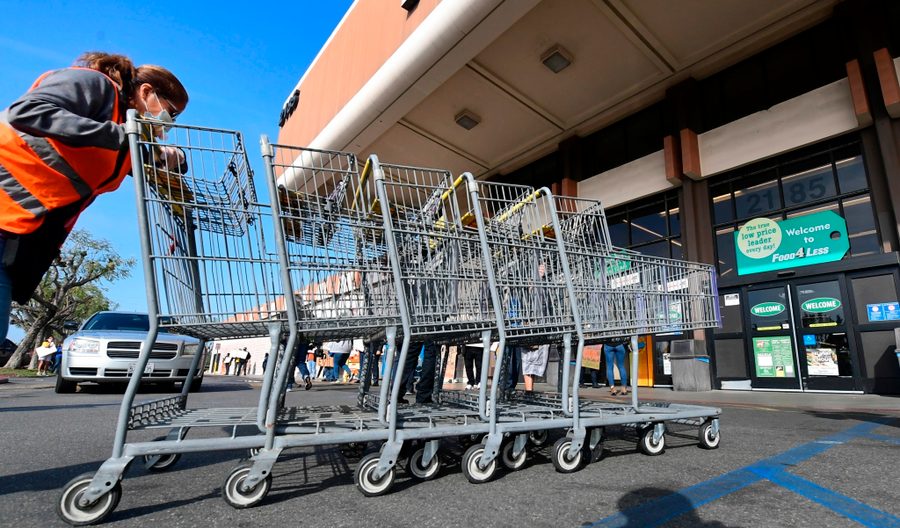Disturbing New Report Shows Dire Conditions For Grocery Workers
A huge new survey of Kroger employees finds homelessness, poverty, and food insecurity are widespread.
Hamilton Nolan

An alarming new survey of thousands of grocery workers across three western U.S. states reveals that they suffer from shockingly high rates of poverty. More than three-quarters of the workers meet the U.S. Department of Agriculture’s definition of “food insecure,” and 14% say they have been homeless within the past year.
The survey, which was funded by the United Food and Commercial Workers Union (UFCW) and performed by the nonprofit research group the Economic Roundtable, drew responses from more than 10,000 workers at Kroger, the largest all-grocery chain in the United States. (Kroger also owns other grocery brands including Fred Meyer, Harris Teeter, and City Market.) The workers surveyed live in Southern California, Washington state, and Colorado, and all of them are UFCW members – indicating that the abysmal conditions reported may in fact be better than the conditions of the average U.S.grocery worker, given the fact that all of those surveyed have at least the minimal protections that union contracts provide.
Peter Dreier, a professor at Occidental College who co-authored the new report, believes that it is one of the largest independent surveys of retail workers ever performed in the United States. “We scoured pretty carefully the terrain of polling and surveys that have been done, and didn’t see anything remotely close,” he says.
Among the survey’s findings:
- Fourteen percent of Kroger workers are now homeless, or have been within the past year. More than one-third say they fear being evicted. Even among full time employees, 15% say that they cannot pay their next rent or mortgage bill.
- The study’s authors calculated that a living wage for Kroger workers would be $22 an hour, working full time – about $46,000 per year. But only 35% of the workers surveyed work full time, and the average wage for a Kroger worker is less than $18 per hour, which amounts to less than $30,000 per year. Even workers who have been at Kroger more than 14 years do not make a living wage, averaging under $21 per hour.
- Contrary to public perception, the majority of Kroger workers have some college or post-graduate education. Eighty five percent are high school graduates. Almost three-quarters of those surveyed say they are not fairly compensated for their experience and work, and more than 90% say they will not have enough money for retirement.
- Despite working around food all day, one-quarter of Kroger workers say that they went hungry in the past year because they could not afford food. Fourteen percent say they receive food stamps. Kroger offers employees only a 10% discount on food at the store.
- A quarter of workers say that their work schedule is so unstable that they do not know it more than one day in advance. Unstable work schedules are correlated with other other problems, like food and housing insecurity.
- A majority of Kroger workers say they were faced with customers who refused to wear masks during the pandemic. Only 43% of those who faced “disrespectful or threatening” customers say that management intervened to help them in those situations.
Though the survey only covers Kroger employees, it is fair to assume that the problems it describes apply to grocery workers across the U.S. Indeed, the descriptions of poverty and lack of workplace safety and support match what workers at other grocery stores have told In These Times repeatedly since the pandemic began.
The attitudes of the Kroger workers surveyed reflect a broad and ongoing decline in the working standards of their entire industry. The percentage of workers who say that the company is heading in the wrong direction is highest among those who have been employed at the company the longest. They are the ones who have been there long enough to live through the erosion of the industry – the decline of grocery store jobs from something that could provide entree into the middle class, to a low-level retail job in which workers are treated as disposable.
That decline in working standards is not driven by the inability of grocery companies to provide for employees. Kroger, which employs close to a half million people, sold more than $132 billion in groceries in 2020, with profits of $4 billion. Since the beginning of the pandemic, Kroger’s stock has risen more than 40%. The desperate situation reported by its work force illustrates the extent to which – even in unionized stores – grocery industry profits flow to investors and management, rather than to workers.
In response to the report’s findings, a Kroger spokesperson sent a statement saying “Since 2017, we’ve invested significantly to increase our national average hourly rate of pay from $13.66 to $16.68, reflecting an increase of $3 per hour or simply stated as a 22% increase… As America’s grocer, we have balanced significant wage investments for our associates while keeping food affordable for the communities we serve.”
The report includes a list of recommendations to remedy the situation, the most important of which is raising Kroger workers up to a living wage. The authors calculate that such a raise would create nearly 8,000 new jobs in the Seattle, Denver, and Southern California regions covered in the report, due primarily to increased spending from grocery workers. Other recommendations include sharply increasing the percentage of Kroger employees who work full time, and raising the company’s food discount for employees to 50%. With the results of the survey in hand, the UFCW now has tangible evidence of the shortcomings in its own contracts to provide for the basic needs of Kroger workers.
“Unionized grocery store workers have already been pushing for many of these improvements during the pandemic. The big difference now is that all of our contracts are soon to be expiring by this summer or before,” says Tom Geiger, special projects director for UFCW Local 21, whose members were included in the survey. “And there is a lot of growing solidarity for addressing grocery store workers’ struggle for higher wages, more secure scheduling, improved safety and more. We will all be pushing hard for those improvements in 2022.”
According to Dreier, the downward trend in economic conditions in the grocery industry has been driven largely by the need to compete with Walmart, which sells more groceries than anyone else in the U.S. He argues that raising wages “would be good for Kroger, because they have enormous turnover. They’re basically operating in a self-destructive way.”
Dreier was not surprised at the suffering among grocery workers, but he was surprised by the sheer scale of the problem. “This is a phenomenon in America that’s almost invisible,” he says. “There are people working full time, living in their cars.”
Hamilton Nolan is a labor writer for In These Times. He has spent the past decade writing about labor and politics for Gawker, Splinter, The Guardian, and elsewhere. More of his work is on Substack.








